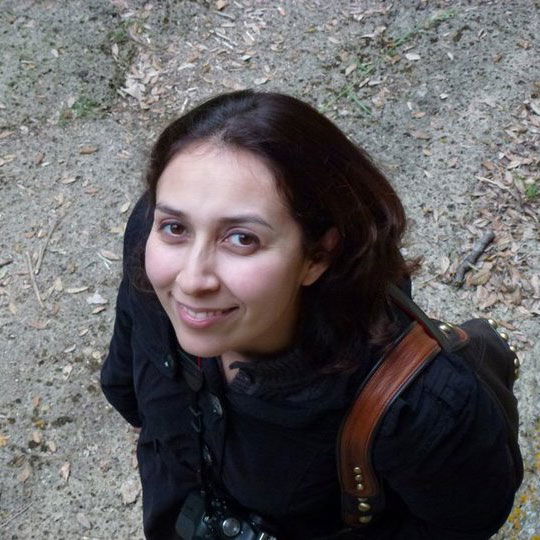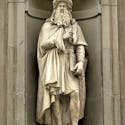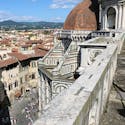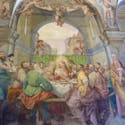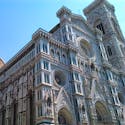Crucifixes and statues
In 2016 (from March through August), the Uffizi Gallery organized a truly exceptional special exhibition showcasing about 50 works of art made out of wood. The exhibit "Fece di scoltura di legname e colorì: 15th century painted wooden sculpture in Florence" brought together for the very first time many works of art of painted wooden sculpture still unknown to or often ignored by the general public (niche area known only to art historians, such as Margrit Lisner). Whether you were able to see the exhibit or not, there were many wonderful works of art that were part of the exhibit that reside in Florence on a permanent basis that would make for an extraordinary itinerary to guide you across many of the churches and museums in Florence.
Here's a brief presentation to some of the artwork that was part of the exhibit:
You will enjoy discovering works by great artists of the 15th century, including Michelangelo, Donatello and Desiderio da Settignano, among others. Painted sculpture in 15th century Florence reflected the importance of sculpture in general and all artists, at one time or another, used it as a model of expression, particularly in the creation of crucifixes, statues of the Madonna, of saints, of Mary Magdalene and other objects often used in a religious context. Artists such as Donatello and Brunelleschi were able to express a new naturalism of the body suffering on the cross that were to become a precious model for whole generations of artists to come.
Now, Donatello and Brunelleschi not only carved their own work but also presumably painted it themselves as they were artists in various fields. Painting statues at that time was considered just as important as the carving in the creation of the whole (not so later in the 16th century). You can see this mastery of the artists in the two superb crucifixes now housed in Santa Croce and Santa Maria Novella.
It is interesting to discover that other workshops specialized in either sculpting or painting and would outsource the other aspect to the other, forging close bonds in the creation of works. For example, Neri di Bicci, who ran a busy workshop in Via Porta Rossa in Florence, was one of the most popular painters hired for that purpose: he painted busts carved by Desiderio da Settignano and crucifixes created by Benedetto da Maiano, and he forged an especially close bond with a sculptor/monk named Don Romualdo da Candeli. The same collaboration is evident in the creation of mixed polyptychs, where altarpieces were composed of a large wooden statue in the center and painted panels on either side. The beauty of these compositions can be seen in the Tabernacle of St. Sebastian (highlighted below) carved by Leonardo del Tasso and painted by Filippino Lippi.
Ready to start your journey? Here is a map with the 13 works of art we highlight in 12 sites to guide your visit to Florence! The starting point of the itinerary is in central Piazza Duomo but you can, of course, follow it in any order that is more convenient for you.
Top Art Painted Wooden Sculpture to Find in Florence
1. Cathedral - Benedetto da Maiano - Crucifix (not part of the exhibit)
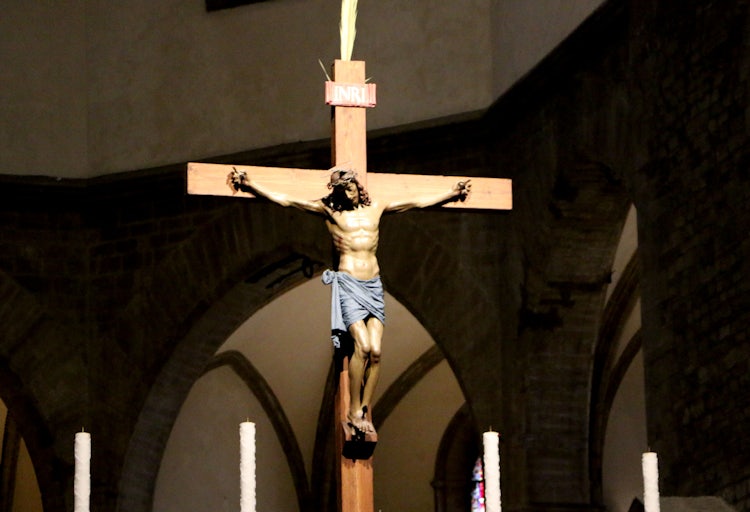
1490-1495
The extraordinary beauty of Crucifix by Benedetto da Maiano, one of his last works, can now be seen after 4 years of restoration with its return to the cathedral in 2014. The colors and quality of the carving can be appreciated now that the patina of a fake bronze applied by Giovanni Dupré in 1867 was removed. The Crucifix lay in Maiano's workshop, from which the Opera del Duomo bought it in 1508. In 1510, Lorenzo di Credi painted the Crucifix and since then it has had its position of honor in the main altar. Notice the muscular torso but sublime facial featured.
2. Museum Opera del Duomo - Donatello - Mary Magdalene (not part of the exhibit)
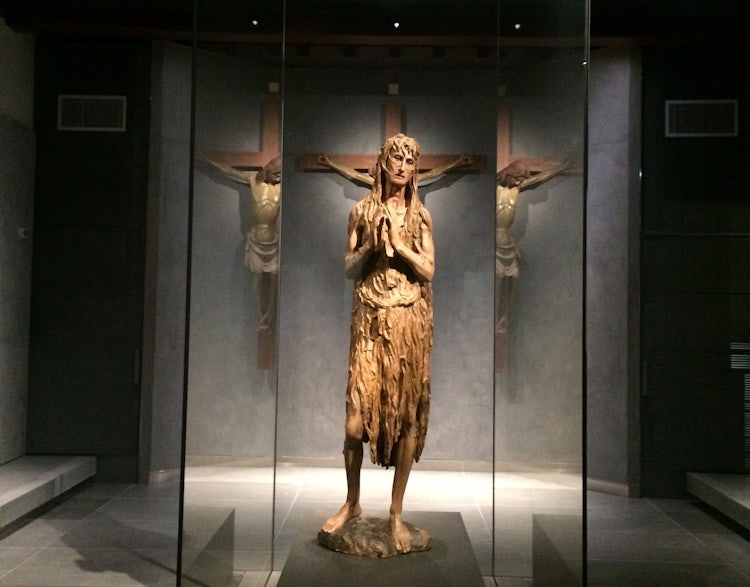
1455 circa
There are no documents to indicate when Magdalene was commissioned or where it first went; the first mention is in 1500 (October 30) when from the Cathedral's workshop it was taken to the baptistery. Documents mention it being placed against the southwest wall of the baptistery, and its praying position towards the right and to the main altar seem to confirm the moment of confirmation of the Magdalene. But there are no clear mentions of whether it was specifically commissioned for the Baptistery from the start, and most art critics date the work toward the end of Donatello's lifetime seeing similarities with other of his work of the period.
The statue was heavily damaged in the Arno flood of 1966 and restoration revealed that the entire sculpture, including the base, is made of one single piece of white poplar tree. The restoration also revealed that Donatello made heavy use of stucco to mold the face as well as neck and hair, the parts that most strike us from the work. The original color of the piece, including the abundant use of gold in her hair. Great innovator in both technique as well as iconography, he created an old Mary Magdalene, thin and frail: penitence and fasting had reduced her to this, yet the love for Christ is still holding her upright and animating her soul. Imagine what she would have looked like in a Baptistery lit bu just candles, with her magnificent golden hair making her appear a divine vision!
Donatello heavily influenced the creation of other Magdalene's in the second half of the 15th century: similar but less dramatic figures can be seen by Desiderio da Settignano (finished by Giovanni d'Andrea) in Santa Trinita (#9 below) and by don Romualdo da Candeli in Empoli.
3. Bargello - Il Vecchietta - San Bernardino da Siena and Andrea del Verrocchio - Crucifix
Lorenzo di Piestro called Il Vecchietta - San Bernardino da Siena (part of the exhibit)
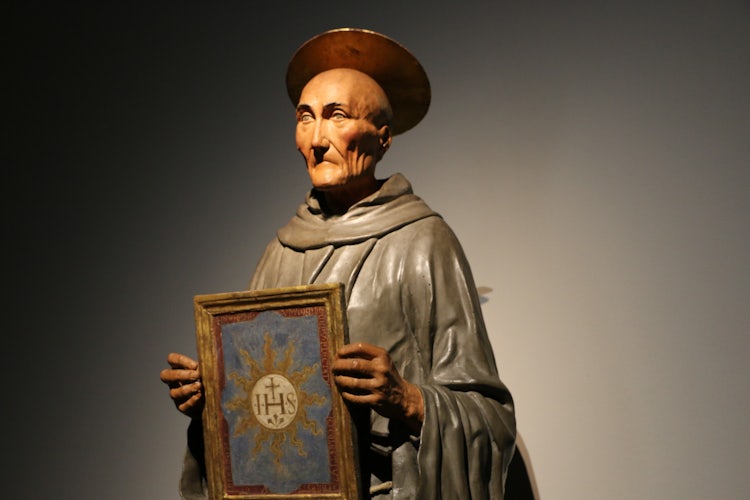
1460-1464
Lorenzo di Pietro, better known as a sculptor, was certainly showing off his mastery in painting as well when he signed the bottom of this work as a painter. Carved in walnut wood, the sculpture was originally in the hands of the San Bernardino confraternity and sold to the Bargello in 1908 by the orphanage of Narni. Vecchiatta had come in close contact with Donatello when the master was in Siena, influence that can be traced in the solid monumentality of the figure, the facial expression and the drape of the clothes, as well as the round faced cherubs at the feet of the aged St. Bernard.
Verrocchio's Crucifix (not part of the exhibit)
1475 circa
The Crucifix arrived at the Bargello from the confraternity of San Girolamo and San Francesco Poverino located in Piazza SS Annunziata. Made out of two sections of linden wood, the wood has been hollowed, carved and reassembled. The head is made out of cork, as the one by Pollaiolo in San Lorenzo (#7 below). The 1994 restoration has reveled that the cloth, soaked in gesso, has golden Kufic letters.
4. Santa Croce - Donatello - Crucifix (part of the exhibit)
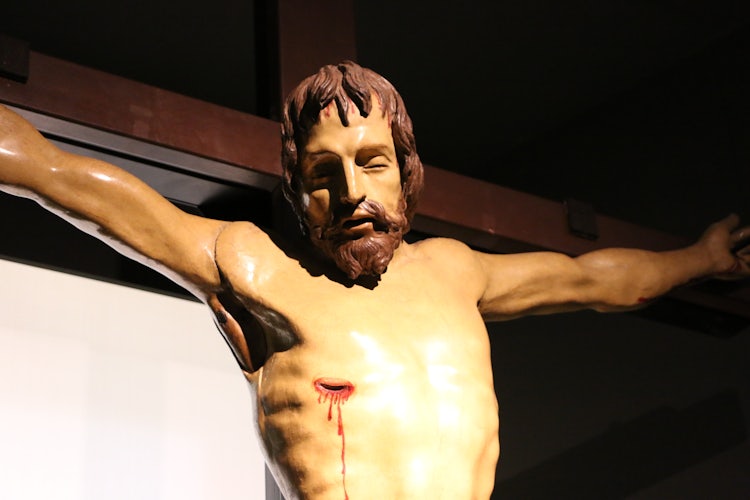
1407-1408 circa
Usually a bit away from the public eye, in the left transept behind the grates of the chapel of San Ludovico. Arrived there around 1570, after restructuring by Giorgio Vasari; before, sources said it was located halfway up the church. Before that, it seems that it's original spot was in an altar in the 4th chapel to the left of the main altar.
The most interesting part of this statue are two mobile arms made possible with two large rotating screws at the shoulders, letting us know that Christ was taken down from the cross during Easter festivities and deposition.
The crucifix, beautiful but not among those more widely works by Donatello works, is however more famous for the story told by Vasari in the biographies of Brunelleschi and Donatello. The young Donatello, in his twenties, was very proud of himself and, as soon as he finished, asked his good friend Brunelleschi what he thought of it. Brunelleschi didn't appear overly excited of the work, commenting that Donatello had placed the body of a farmer on the cross instead of that of Christ. Donatello was deeply offended and challenged Brunelleschi to do better. Thus the result is the crucifix you see in Santa Maria Novella, upon which it is said Donatello admitted defeat, saying Brunelleschi was certainly adept at carving Christ and Donatello would make farmers.
Brunelleschi was certainly referring to the irregular proportions of the body, with a large torso and thin waist and too high a forehead but the tired, suffering of the facial expression is certainly not that of a farmer.
5. S. Ambrogio - Leonardo del Tasso and Filippino Lippi and Workshop - San Sebastiano (part of the exhibit)
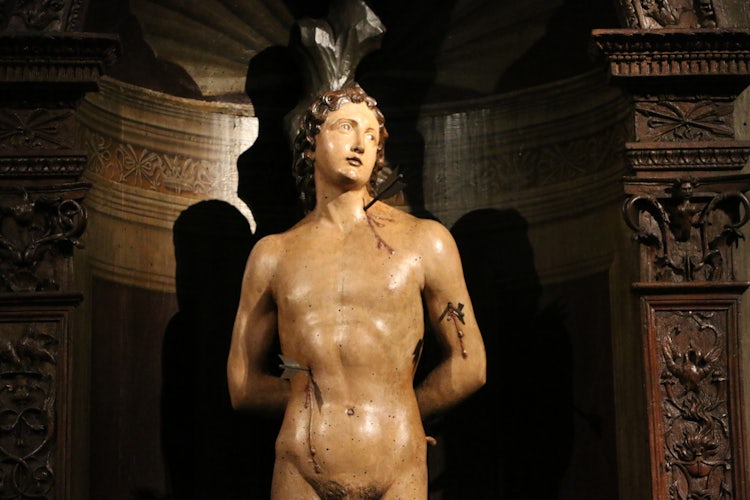
1500 circa
Leonardo del Tasso, who worked in Benedetto da Maiano's workshop, carved the wood tabernacle and St. Sebastian for the family chapel in Sant'Ambrogio, with the niche above painted by Lippi's workshop. The statue and wooden tabernacle were already noticed for their beauty and the statue's svelte, classical figure with its perfect curls. The tabernacle acts as a frame for the sculpture, one of the first works to show a complete presentation of monumental sculptures within an architectural context.
6. SS Annunziata - Giuliano da Sangallo and Antonio da Sangallo "il Vecchio" - Crucifix (part of the exhibit)
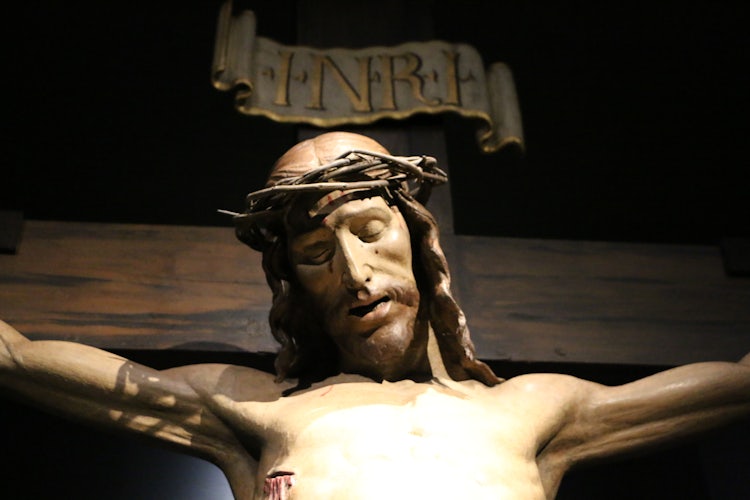
1481-1482
Back in the 15th century, when discussion was centered on "which was the nobler art, sculpture or painting?", and where Vasari generally considered painting to rule, conceded that with Francesco Bocchi's 1592 writing that the two most magnificent works in SS Annunziata were Antonio da Sangallo's Crucifix and Bandinelli's Christ, two pieces of sculpture, one of marble and one of wood. The Crucifix hung in the main altar, with the addition of works by Perugino and Lippi but little by little the altar was taken apart and the Crucifix first ended up in a side chamber where the silver was kept and only moved back into the church in the 1950s to the second chapel on the right nave. While most attribute the entire work to Antonio, part of the work is also attributed to Giuliano for evidence in documents that he received most of the payments for the commission. It is likely that Antonio did the majority of the work, under the supervision of the older brother.
7. Basilica of San Lorenzo - Antonio del Pollaiolo - Crucifix (not part of the exhibit)
1470-1480 circa
This marvelous sculpture, almost hidden in a not-so-visited chapel on the right transept within the Basilica of San Lorenzo, was created by assembling various layers of cork, connected with pegs and cords, then sculpted with a thin layer of gesso, then everything painted. The original painting is that still seen today. The cross and blue loin cloth are also all originals from the 15th century. Considering its fragility, its good state can almost be seen as miraculous: the only parts that have been redone over the centuries are the fingers and toes.
The crucifix last saw a restoration in 2014 when the statue traveled to Milan for an exhibit on the Pallaiolo brothers and became the surprising star of the show. The light materials used to create the crucifix fall in with its use: to be carried around in processions. Originally in a smaller church on Via San Gallo, it passed into private hands and only in the early 1800s it was donated to San Lorenzo.
Make sure to note the athletic build of Christ's body as opposed to the tragic mask the face has been reduced to: protruding cheekbones, sunken eyes, blubbery lips closing over the teeth.
8. Basilica of Santa Maria Novella - Filippo Brunelleschi - Crucifix (not part of the exhibit)

1410-1415 circa
Brunelleschi's Crucifx was the masterpiece of all Renaissance crucifixes, at least until Michelangelo comes along. It was the first "modern" figure in the history of Italian art (no longer gothic in style). Noble and, at the same time, natural, with perfect proportions, free from traditional conventions starting from the loin cloth which is no longer carved but an actual piece of cloth placed over the nude figure.
It was right away taken as a model by Masaccio and Michelozzo, who referred to it for their own work. It is said Brunelleschi carved it as a direct challenge from his friend Donatello (read above for full story). It remains as the last wooden sculpture by Brunelleschi after his Magdalene was destroyed in a fire in Santo Spirito in 1471.
The Crucifx remained in Brunelleschi's workshop until 1445 and maybe was donated by himself to the Dominicans of Santa Maria Novella.
9. Santa Trinita - Desiderio da Settignano - Magdalene (part of the exhibit)

1458-1459 // before 1499
This haunting Mary Magdalene was started by Desiderio da Settignano but completed by Giovanni d'Andrea (an artist who worked with Andrea del Verrocchio) only toward the end of the century. While the work has some aspects that remind one of Donatello's Mary in the Opera del Duomo Museum, there are some traits such as the more elegant pose that could mimic another statue, perhaps the Mary Magdalene that Brunelleschi made but which was lost in a fire in Santo Spirito. Today, the statue is within the Spini Chapel on the left nave of the Santa Trinita church.
10. Church of Santo Spirito - Michelangelo - Crucifix

1493 circa
One of Michelangelo's earliest works, it can be found within the sacristy to the left as you enter the church. Made out of linden wood, it was made for Santo Spirito shortly after the death of Lorenzo il Magnifico and was placed near the main altar when Michelangelo was a guest at the convent. It was moved in the early 1600s when a new altar was made to a side chapel and then into the convent itself, where no one bothered to cite its placement. Through the years, the friars could no longer remember which one was Michelangelo's. All of the other crucifixes in the church were examined to try to identify Michelangelo's and it wasn't recognized until the 1960s!
Many contested that it was his work, considering the youthful body, fragile and sweet and the fact that the medium is wood, not often cited as one he used to work with. Despite this, it is today recognized as Michelangelo's first "public" work given its original important placement in the main altar.
11. Oratorio di S. Sebastiano (called dei Bini) - Artist close to Donatello - Crucifix (part of the exhibit)
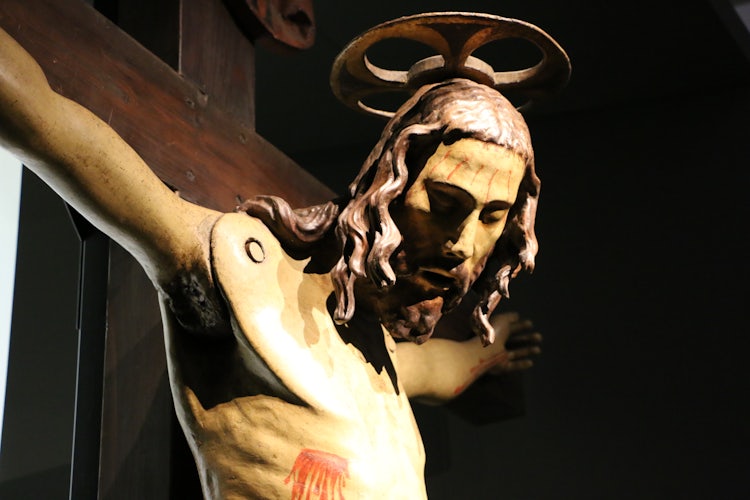
1410-1415 circa
This is one of the Crucifixes that was of most impact at the exhibit. Great expressive features and well studied anatomical proportions, such that Margrit Lisner, a German art historian who studied Florentine wooden crucifixes in the 1960s, deemed it just as important as Donatello's and Brunelleschi's Crucifixes for its quality, invention and creation. Notice the two arms fixed with pegs to make the arms movable: this means Christ was taken down from the cross during Holy Week celebrations. It is also carved completely in the round, even in the back of the head and body whereas many crucifixes, destined to be hanging on the cross, are not developed fully on the back part. The Crucifix is to found on the counter-facade of the Oratory of St. Sebastian, where a small but important collection of sacred works is housed in the Oltrarno open, since in December 2002. We highly encourage you to go to this small museum and see this Crucifix after you've seen the others to be able to see the extraordinary emotional impact of this work, even without a big name attached.
12. Church of San Niccolo Oltrarno - Michelozzo - Crucifix (part of the exhibit)

1435 circa
Rediscovered only 50 years ago, it was half submerged by the flood of 1966 and attended 20 years before it was restored. So it was only recently returned to its original placement in the second altar to the right in the nave of San Niccolò, whose actual setup was created in 1584 by the Cavalloni family. The ancestors of the Cavalloni family were tied to Donatello, and whose work Michelozzo is said to have taken as model: similarly angled arms as Donatello's Crucifix in Padova, open palms, prominent torso and hair in wild disarray.
